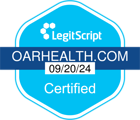The Road To Recovery: 3 Evidence-Based Treatments

In This Article
Recovery from alcohol is both a journey and a destination.
Like all journeys, there are many paths to get to the arrival point. At Oar Health, we celebrate all successful roads you might follow to either drink less, or to stop drinking altogether. We also know how challenging finding treatment can be and that finding the best treatment for you can take time.
Recovery can take multiple tries because of the nature of Alcohol Use Disorder (AUD) — it’s a brain disorder, which makes white-knuckling recovery ever-so challenging. People may relapse or continue struggling with problem drinking for a plethora of reasons; but lack of proper treatment is a core cause.
Why Is Treatment Not One Size Fits All?
Though varying methods can be successful for recovery, multiple reasons support why treatment is not universal. Brain function, cultural factors, higher exposure to triggers, and the severity of someone’s AUD all can play a role in how effective a treatment approach is.
People have different goals when it comes to recovery. For some, total abstinence is necessary. For others, alcohol reduction might be the endpoint. Some treatments encourage total abstinence, such as Alcoholics Anonymous (AA), whereas medication-assisted therapy, like naltrexone, can support either abstinence or alcohol reduction.
There’s no one perfect formula for achieving recovery. No one’s recovery journey looks exactly alike, though people may share similar routes to get there. Whichever treatment you explore, at Oar Health we advise using an evidence-based approach, which can strengthen your support and increase the effectiveness of recovery.
What Are the Three Types of Evidence-Based Treatments?
According to the National Institute of Alcohol and Abuse, there are three main branches of evidence-based treatment options for AUD. An evidence-based approach has undergone rigorous research metrics and is the best approach available (1).
Behavioral Health Therapy
Psychotherapy is a common treatment for AUD. Cognitive Behavioral Therapy (CBT) is considered the gold standard of behavioral health treatments for AUD, but multiple science-backed approaches exist. There’s also motivation enhancement therapy, mindfulness-based therapies, contingency management, family therapy, and 12-step counseling. A good connection with a therapist and a specialization in addiction are helpful guidelines to start with.
Medication-Assisted Therapy
Though lesser utilized and known about, there are several FDA-approved medications for AUD:
- Acamprosate:
- Disulfiram:
- Naltrexone:
Mutual Support Groups
Mutual support groups are accessible ways to receive peer-led support to stop or reduce drinking. Though it’s common to think of 12-step programs such as Alcoholics Anonymous (AA), there are many other support groups, such as SMART Recovery, Refuge Recovery, Women for Sobriety, and LifeRing. These programs are each comparable in effectiveness to 12-step programs (3).
Recovery Intensity Needs
Just as there are multiple approaches to recovery, there are a few modalities of care. These levels help determine the severity and urgency of intervention for AUD.
Highest Levels Of Care
Individuals detoxing from alcohol or facing withdrawal symptoms may need higher levels of care to monitor symptoms. It’s essential to note that detox does not equate to treatment; after a detox, someone will need further treatment. High levels of care can include intensive inpatient rehabilitation programs that can manage withdrawal symptoms, low or high-intensity residential programs, outpatient programs, or partial hospitalization.
Lower Levels Of Care
It’s important to note that just because someone warrants a lower level of care does not mean care is unnecessary. People can also move between the levels of care at different recovery points. Some lower levels of care include building your care team with an addiction specialist or seeking telehealth psychotherapy or medicine.
All the treatment options are different. While they might focus on various aspects of addiction, they share the same goals—alcohol reduction or abstinence. You can choose one treatment approach or combine them. Receiving any treatment is better than no treatment.
But Which Is Best?
AUD is complex. Because of this, no one approach is universally regarded as the best. The treatment that’s right for you is the best treatment. No one way fast-tracks recovery. If you are unsure about your treatment needs or think you may need a higher level of care, your healthcare professional can help you determine the necessary approach.
You Are In Charge of Your Recovery
You can pull from different approaches and use what works for you. AA recommends attending 90 meetings in 90 days for those just starting. This frequency may not be sustainable for some, or it may feel helpful. Some might need the support of going to groups; others may prefer to work one-on-one.
No Treatment Option Is Perfect
No medication is a magic pill. Going to therapy, or meetings, cannot 'cure' addiction, as it’s chronic. AA holds sobriety as its sole goal and is steeped in spiritual undertones that are not for everyone, though it purports not to have a religious affiliation. So, while no one treatment option is perfect, treatment can help you manage AUD, achieve your goals, and build a meaningful life. Your choice should include what resonates and the guidance of a specialist.
Honoring Your Needs
If someone does not think that AA would be a good fit for them or has tried AA with unsuccessful results, their preferences, experiences, and values should be honored. Oar Health believes, strongly, that it’s essential that those struggling with AUD are offered a menu of evidence-based approaches.
In the United States, alcohol misuse is a sobering issue. Though the problem is growing, treatment of all kinds remains vastly underutilized. We support your road to whichever recovery path you choose.
Are You Drinking Too Much?
Is drinking affecting your job? Is alcohol harming your health or relationships? Does your drinking worry you? Ever tried to drink less but failed?
If any of this sounds familiar, Oar Health might be right for you. Oar Health offers medication FDA-approved for the treatment of alcohol problems. A daily pill to drink less or quit.
About The Author
Xenia Ellenbogen (she/they) is a journalist specializing in health, mental health, and wellness. Her writing has appeared in publications such as Everyday Health, Well+Good, Rewire News Group, Prism, and more.
Related Articles
- How It Works
- Alcohol & Health
- Alcohol Misuse & Alcohol Use Disorder
- Strategies to Drink Less or Quit
- Treatment Options
- Medication-Assisted Treatment
- Recovery Stories
- Member Stories
- Moderation Stories
- Sobriety Stories
- ¹ Oar Health membership plans include access to the Oar Health platform, virtual consultations with a healthcare professional, and medication if prescribed by a healthcare provider. 3 month membership plan costs $297, equating to $99/mo.
- ² Self-reported by members after 6 months of Oar Health membership.
- ³ Verywell Health survey of Oar Health members, published March, 2023.
- ⁴ Prescription medication is available only if prescribed by a licensed clinician.




